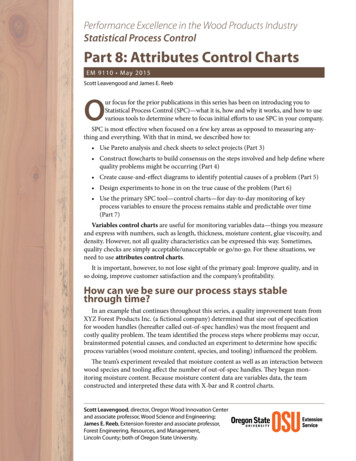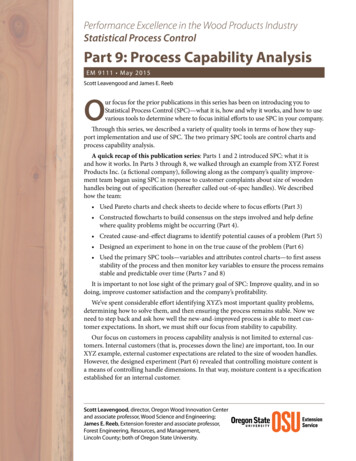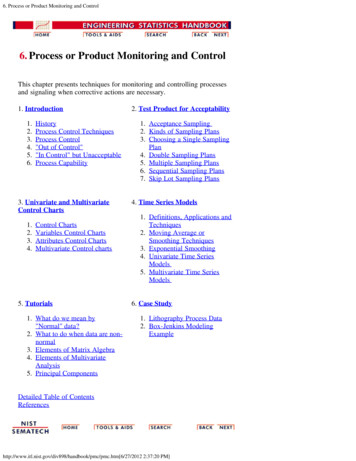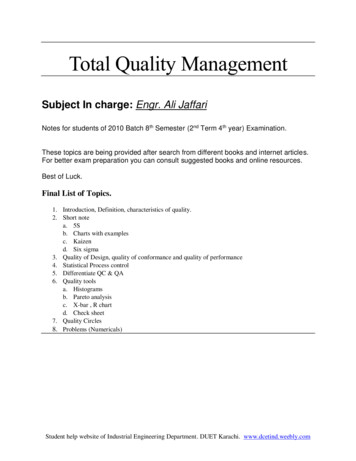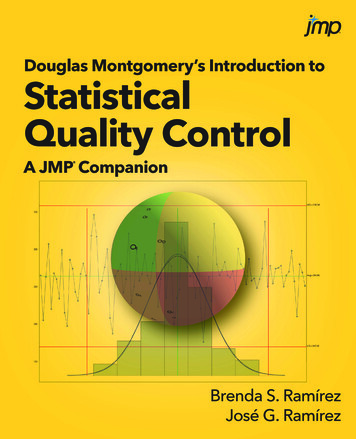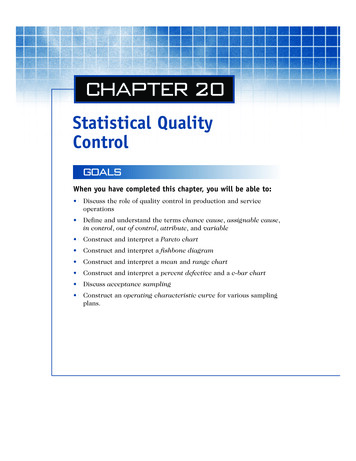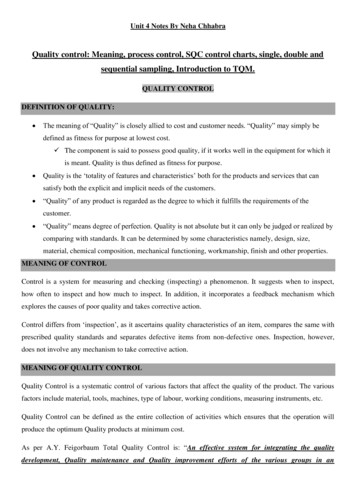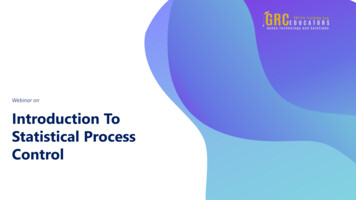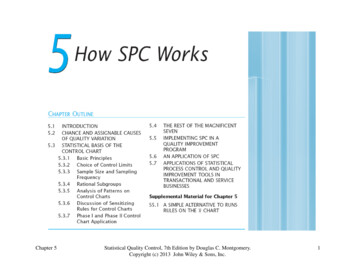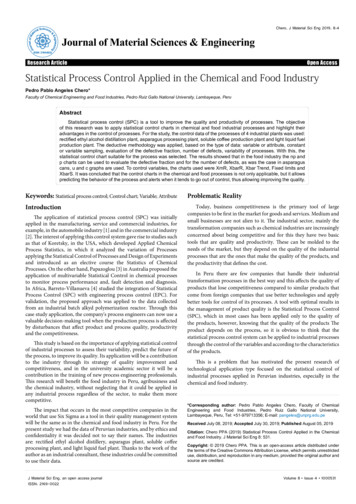
Transcription
Chero, J Material Sci Eng 2019, 8:4Journal of Material Sciences & EngineeringineerinEngglurna of MatJo&ScienceialserISSN: 2169-0022ResearchArticleResearch ArticleOpenOpenAccessAccessStatistical Process Control Applied in the Chemical and Food IndustryPedro Pablo Angeles Chero*Faculty of Chemical Engineering and Food Industries, Pedro Ruiz Gallo National University, Lambayeque, PeruAbstractStatistical process control (SPC) is a tool to improve the quality and productivity of processes. The objectiveof this research was to apply statistical control charts in chemical and food industrial processes and highlight theiradvantages in the control of processes. For the study, the control data of the processes of 4 industrial plants was used:rectified ethyl alcohol distillation plant, asparagus processing plant, soluble coffee production plant and light liquid fuelproduction plant. The deductive methodology was applied, based on the type of data: variable or attribute, constantor variable sampling, evaluation of the defective fraction, number of defects, variability of processes. With this, thestatistical control chart suitable for the process was selected. The results showed that in the food industry the np andp charts can be used to evaluate the defective fraction and for the number of defects, as was the case in asparaguscans, u and c graphs are used. To control variables, the charts used were XmR, XbarR, Xbar Trend, Fixed limits andXbarS. It was concluded that the control charts in the chemical and food processes is not only applicable, but it allowspredicting the behavior of the process and alerts when it tends to go out of control, thus allowing improving the quality.Keywords: Statistical process control; Control chart; Variable; AttributeProblematic RealityIntroductionToday, business competitiveness is the primary tool of largecompanies to be first in the market for goods and services. Medium andsmall businesses are not alien to it. The industrial sector, mainly thetransformation companies such as chemical industries are increasinglyconcerned about being competitive and for this they have two basictools that are quality and productivity. These can be molded to theneeds of the market, but they depend on the quality of the industrialprocesses that are the ones that make the quality of the products, andthe productivity that defines the cost.The application of statistical process control (SPC) was initiallyapplied in the manufacturing, service and commercial industries, forexample, in the automobile industry [1] and in the commercial industry[2]. The interest of applying this control system gave rise to studies suchas that of Koretsky, in the USA, which developed Applied ChemicalProcess Statistics, in which it analyzed the variation of Processesapplying the Statistical Control of Processes and Design of Experimentsand introduced as an elective course the Statistics of ChemicalProcesses. On the other hand, Papazoglou [3] in Australia proposed theapplication of multivariable Statistical Control in chemical processesto monitor process performance and, fault detection and diagnosis.In Africa, Barreto-Villanueva [4] studied the integration of StatisticalProcess Control (SPC) with engineering process control (EPC). Forvalidation, the proposed approach was applied to the data collectedfrom an industrial batch alkyd polymerization reactor. Through thiscase study application, the company's process engineers can now use avaluable decision-making tool when the production process is affectedby disturbances that affect product and process quality, productivityand the competitiveness.This study is based on the importance of applying statistical controlof industrial processes to assess their variability, predict the future ofthe process, to improve its quality. Its application will be a contributionto the industry through its strategy of quality improvement andcompetitiveness, and in the university academic sector it will be acontribution in the training of new process engineering professionals.This research will benefit the food industry in Peru, agribusiness andthe chemical industry, without neglecting that it could be applied inany industrial process regardless of the sector, to make them morecompetitive.The impact that occurs in the most competitive companies in theworld that use Six Sigma as a tool in their quality management systemwill be the same as in the chemical and food industry in Peru. For thepresent study we had the data of Peruvian industries, and by ethics andconfidentiality it was decided not to say their names. The industriesare: rectified ethyl alcohol distillery, asparagus plant, soluble coffeeprocessing plant, and light liquid fuel plant. Thanks to the work of theauthor as an industrial consultant, these industries could be committedto use their data.J Material Sci Eng, an open access journalISSN: 2169-0022In Peru there are few companies that handle their industrialtransformation processes in the best way and this affects the quality ofproducts that lose competitiveness compared to similar products thatcome from foreign companies that use better technologies and applybetter tools for control of its processes. A tool with optimal results inthe management of product quality is the Statistical Process Control(SPC), which in most cases has been applied only to the quality ofthe products, however, knowing that the quality of the products Theproduct depends on the process, so it is obvious to think that thestatistical process control system can be applied to industrial processesthrough the control of the variables and according to the characteristicsof the products.This is a problem that has motivated the present research oftechnological application type focused on the statistical control ofindustrial processes applied in Peruvian industries, especially in thechemical and food industry.*Corresponding author: Pedro Pablo Angeles Chero, Faculty of ChemicalEngineering and Food Industries, Pedro Ruiz Gallo National University,Lambayeque, Peru, Tel: 51-979713356; E-mail: pangeles@unprg.edu.peReceived July 08, 2019; Accepted July 30, 2019; Published August 05, 2019Citation: Chero PPA (2019) Statistical Process Control Applied in the Chemicaland Food Industry. J Material Sci Eng 8: 531.Copyright: 2019 Chero PPA. This is an open-access article distributed underthe terms of the Creative Commons Attribution License, which permits unrestricteduse, distribution, and reproduction in any medium, provided the original author andsource are credited.Volume 8 Issue 4 1000531
Citation: Chero PPA (2019) Statistical Process Control Applied in the Chemical and Food Industry. J Material Sci Eng 8: 531.Page 2 of 7Theoretical FrameworkStatistical control of processesTheoretical basisTo know the type of cause of the variability, Shewhart [9] createdthe control graphs, which consist of three lines and points on a graph.The dots represent the measurements of a quality characteristic. Thecenter line represents the average of the point values or the objectivevalue that is evaluated. The other two lines represent the upper andlower control limits.The theoretical basis focuses on the theoretical foundations ofStatistical Process Control and on the unit operations of industrialprocesses. Statistics in the process industry seeks to implement theprobabilistic and statistical procedures of analysis and interpretationof data from a set of elements called industrial statistics, which helpsto make decisions in the control of industrial processes. This is how inthe management and interpretation of data in industrial processes, wegenerally use the measures of central tendency, and for the decisionmaking process management you can use the statistical tools forprocess control, especially, control charts. The statistical managementof industrial process data obeys certain statistical methods.Variability in industrial processesNo two products or services are exactly the same because theprocesses by which they are produced include many causes of variation,even when these processes are performed as planned [5]. The variationin quality, gives rise to an important task in quality control that consistsin determining the range of natural random variation in the process.For example, the bottle of a soda called Cola Lux should contain anaverage of 16 ounces of liquid, but it is found that its volume whenleaving the process varies between 15.8 and 16.2 ounces. If this is thecase, the production process should be controlled to ensure that thefilling volume remains within this range. If production were outsidethis range, such as bottles with an average content of 15.6 ounces, thenit means that there is a problem in the process because the variation isgreater than the natural random variation.Types of variationShewhart [6] of Bell Telephone Laboratories developed the newvariation management paradigm, basing his concept on the idea that aquality characteristic has one of two types of variation causes: Common cause: It is the natural variation that exists withinany process therefore they are causes that are always part of theprocess and affect all those who work in it. Special or assignable cause: It is the variation that is due tosomething out of the ordinary. Normally it is not part of theprocess, or does not affect everyone, but they are attributable tospecific circumstances. These types of causes are analyzed andcorrected so that they do not happen again. It can be detectedbecause it is not always active in the process [7].Types of control chartsControl charts are divided into: Charts for attribute control: p,np, c and u; and Charts for variable control: XmR, XbarR, ImR, XmRtrend, XbarS, among others.p chart: It is used to evaluate the defected fraction. Defective itemscan be counted and the sample size is not constant. The equations tobuild the charts are: P nILC p (1)p (1 p )n(2)iLSC p 3p (1 p )(3)nwhere, LC is Central Line, LSC is Upper Control Limit, LIC is LowerControl Limit, it is average of defective elements, and n is sample size.LIC p 3np chart: It is used to evaluate the defective fraction when it is easyto count the number of defective elements and the sample size is alwaysthe same [10]. The equations to build the charts are: np niLC np (4)np (1 n p )n(5)iLSC np 3np (1 np )nwhere np is average of defective elements.LIC np 3(6a)c Chart: It is used when a small number of defects can be countedin a large opportunity area, or in an article or product, and when thesample size is constant [10]. The equations to build the graphs are: cThe toleranceLC c (6b)In industrial processes there will always be variations in productcharacteristics, such as length, diameter, thickness, weight, volume,density, etc., due to the inherent variability that occurs in machines,tools, raw materials, and human operators The presence of an inevitablevariation (disturbance), and the interchangeability results in specifyinglimits for the variation of any quality characteristic, which are thespecifications required by the customer. This acceptable variation iscalled tolerance.LSC c 3 c(7)LIC c 3 c(8)The tolerance in the quality of a product is specified by thecustomer. The estimation of the natural tolerance limits of a processis an important problem with many significant practical implications.If the values of the measurements in the data exceed the tolerancelimits, an extremely high percentage of production will be out of thespecifications, which will result in a high loss or reprocess rate [8].J Material Sci Eng, an open access journalISSN: 2169-0022inwhere c is average of defective elements.u chart: It is used when you can count the defects in an item orproduct, and the sample size varies [10]. The equations to build thegraph are.LC u u niiLSC 3(9)(10)Volume 8 Issue 4 1000531
Citation: Chero PPA (2019) Statistical Process Control Applied in the Chemical and Food Industry. J Material Sci Eng 8: 531.Page 3 of 7LIC u 3uni(11)where u is average of defective elements.XmR/ImR chart (individual motion range chart): The XmRcontrol chart tracks individual data elements and indicates observationwith X as the average of the data, and mR indicates the range of motion[11]. The equations to build the charts are:LC X 1 X 2 X 3 X nn(12)LSC X A3 S(13) X A3 SLIC(14)For R ChartLC R X max X min(15)LSC D4 R(16)IC D3 R(17)where, R is average range, X is average, and X is the average of theaverages, X max y X min they are the maximum and minimum values ofthe sample. A2, A3, D3, D4 are constants of control graphs and areread in Table 1.useful when you do this several times a day. Data collection could beexpensive if it is continuous [12].XmR trend graph: Graph that is applied to determine the trend ofvariable data.Control charts for special caseAnalysis of means (ANOM): It is used to analyze the differencesbetween the means.CUSUM chart: They are cumulative sum used to detect smallchanges in a process [12].EWMA chart: It is used when you have a sample and you want todetect small changes in performance.Fixed Limit chart: This chart is used to enter historical controllimits or specification limits (for example, quality standard). It worksjust like any other control chart, except that it uses these control limitsinstead of calculated control limits.Moving average control chart: This control chart is used for whenthere is only one sample and you want to evaluate the process changesusing a simple moving average (that is, not the EWMA).Pre-control chart: Used when you have less than 20 data points.The QI Macros for Excel has an easy-to-use pre-control chart template.XbarR chart: The Xbar and R charts are used to monitor theaverage and variation of a process based on samples taken from theprocess at certain times (hours, shifts, days, weeks, etc.). The equationsthat are used are the same as the previous ones.Pre Control chart template: A template to make a pre control isa quality assurance alternative. It can be built in Excel or use the QiMacros template [13].XbarS chart: The Mean (X) and Standard Deviation (S) chart isused to evaluate the stability of processes with variable data. This chartcan help evaluate the cycle time for almost any process and is especiallyBibliographic material and Qi Macros SPC Software for Excel,to analyze the data, select, build and interpret the control charts ofvariables and attributes applied in the processes. The deductive methodSample size, nXbar chart constantsMaterials and MethodsConstant for estimated sigmaConstants for chart able 1: Control chart constants.J Material Sci Eng, an open access journalISSN: 2169-0022Volume 8 Issue 4 1000531
Citation: Chero PPA (2019) Statistical Process Control Applied in the Chemical and Food Industry. J Material Sci Eng 8: 531.Page 4 of 7was applied, based on the type of data (attributes or variables); thealgorithm of Figure 1 was used.Control charts are identified for application in the processes of thechemical and food industry. If the data are attributes, there are two questions: Are the datacountable? Is the sample size constant or does it vary? Defective fraction or the number of defects? If the data is variable, the question is: were the data collectedin sub groups? If so: the sub group 8 or 8? Does each sampling report several data from several elementsor are they individual data?The questions are asked and answered using the algorithm inFigure 1.ResultsThe control of the temperature of the coffee powder at the exit ofthe dryer in one day of operation reported the following data (Table 2).Assisted by algorithm, the graph selected for variable data is XmR,but to comply with the internal standard of 30 C to 35 C, the controlchart is Fixed Limit and an R chart to assess process variability. Tograph, the equations of the XmR and fixed-limit charts were usedwith the help of QiMacros software [11]. The upper and lower limitscorrespond to the limits of the internal standard (Upper control limit,35 C, and Lower Control Limit, 30 C). For the variability of the process,an R chart was constructed, as shown in Figures 2 and 3.Interpretation: The fixed limits chart shows permissibletemperatures between 30 and 35 C, but wide variability is observed(points highlighted at 9.0 am, 5.0 pm, 6.0 pm, 5.0 am and 6.0 am) somuch that exceeded the limits, what which indicates that the process isout of control. The R chart confirms the process variability in Figure 3, withFigure 1: Algorithm to select the type of control chart.Figure 2: Fixed limit control chart for coffee powder temperature.J Material Sci Eng, an open access journalISSN: 2169-0022Volume 8 Issue 4 1000531
Citation: Chero PPA (2019) Statistical Process Control Applied in the Chemical and Food Industry. J Material Sci Eng 8: 531.Page 5 of 7Figure 3: mR Chart for the temperature of coffee powder in the dryer discharge.HourT, CHourT, CHourT, 326.0pm363.0 0pm32Hour% saltTable 2: Coffee powder temperature at the dryer outlet ( C).% saltHour8:0amHour2.154:0am% salt2.1212:0 m2.106:0pm2.073:0pm2.111.0pm2.107:0pm2.07Table 3: Percentage of salt in asparagus governing liquid.wide ranges between 3.0 pm and 8.0 pm while between 10.0 pm and3.0 am the ranges are almost zero. The supervisor of the next shift,determined that the cause of the variability was due to mechanicalproblems that affected the air flow (assignable cause), and correctedthe problem. This improved product quality.In the asparagus processing plant, the brine content in thegovernment liquid was evaluated. In a day of operations the datacontrol is carried out every hour, and in Table 3 the control results areshown that are subjected to a statistical control with control charts. Thedata is as follows:second shifts are new workers who were not trained, while the thirdshift operator has more than 5 years in the position. In the trend chart(XbarR trend) of Figure 6 you can see that the salt concentration theliquid of government. The chart shows the adjustment of the line to thetrend that should be 0.80, here it is smaller and indicates a downwardtrend. Ryx is the linear correlation coefficient, and 0.473 is a very lowcorrelation supported by the variability in the data. The slope is slightlynegative that confirms the trend. The standard deviation is minimalgiven the latest data and the probability that it is less than Ryx indicatesand reaffirms that there is no significant correlation between the data,therefore, the control data tends towards the lower control limit andis an alert for review the process and input preparation of the salinesolution.Due to the type of variables available, an XmR chart was selectedand because of the suspicion of a drop in the values at the end of theshift, an XmR Trend chart was prepared, as shown in Figures 4-6.DiscussionInterpretation: X Chart shows process instability between 12.0 pmand 7.0 pm which is then normalized and the data is at the averagelimit, with a minimum variability that is unusual between 8.0 pmand 5.0 am. On two occasions, the % brine in the government liquidis above the upper limit and the same applies to the ranges betweenthe data as shown in Figure 5. The attributable cause as determinedby the shift supervisor was that the operators of the shift first andIn the statistical control charts that were applied to asparagus,rectified ethyl alcohol, and light fuel processes, it is demonstrated thatthe process performance can be improved by correcting the causesof defects or disturbances that affect quality, very similar to resultsof Papazoglou [3], who monitored the process performance and thedetection and diagnosis of failures by monitoring the performance ofthe polymerization process.J Material Sci Eng, an open access journalISSN: 2169-0022Volume 8 Issue 4 1000531
Citation: Chero PPA (2019) Statistical Process Control Applied in the Chemical and Food Industry. J Material Sci Eng 8: 531.Page 6 of 7Figure 4: X Chart to control % salt in government liquid in asparagus can. Source: Prepared by author with QiMacros.Figure 5: mR Chart for to control the stability of the government liquid preparation process.Figure 6: Trend XmR chart to identify trend of the % salt data in the government liquid preparation process.Another important aspect to highlight in this study is the advantagethat control charts allow to monitor the variability of the process andcorrect it at the moment, which reduces the downtime in the process,reduces waste, and improves quality of the product. This was alsoconfirmed by Ali, in London, in the application of quality controltechniques to ensure the quality of the designed and manufacturedparts, which were carried out in the Engineering and Manufacturingarea of the Department of Technical Services of a recognized Factory,using the Statistical Process Control charts according to its study calledStatistical Process Control for Total Quality based on the routinepractice of a technique.An advantage of this study is that you can improve profitabilityin industries; however, companies hardly grant facilities and less data.As it could be seen, with the control charts the correction can be madeas soon as the charts indicate that the process is deviating and close togetting out of control and with greater precision when it is a trend chartJ Material Sci Eng, an open access journalISSN: 2169-0022that forecasts what can happen In the near future. It should be notedthat Madanhirea et al. in South Africa [14], focused on improvingquality and profitability, and demonstrated that the SPC had a clearadvantage over quality methods, such as inspection of the final product,as described in his research study, Application of Statistical ProcessControl (SPC) in Manufacturing Industry in a Developing Country.It is important to note that at the national level no studies havebeen carried out in this regard, which is a major reason to promote itsapplication in the agribusiness, chemical and food industry that have agreater presence in our country [15-20].ConclusionsTo apply the statistical process control charts, control data from: Rectified ethanol distillation plant,Asparagus processing plant,Volume 8 Issue 4 1000531
Citation: Chero PPA (2019) Statistical Process Control Applied in the Chemical and Food Industry. J Material Sci Eng 8: 531.Page 7 of 7 Soluble coffee production plant, Light liquid fuel plant.From the data mining of the processes of the mentioned processplants, data of variables and attributes to which the statistical processcontrol was applied was taken for convenience. The variables were:% of fermentation ethanol, G.L. of rectified ethyl alcohol, coolingtemperature of light liquid fuel, % of salt in asparagus governingliquid. In addition to these controls, the number of defects in theclosure of asparagus cans, temperature of dry coffee powder, Brix ofcoffee extract, and water temperature for coffee extractors were alsoevaluated. The charts used for process control were:detecting when the process does not do what it is used to do,when the results have a tendency to go outside the permissiblelimits and identify when there are assignable causes that affectthe process and make it go out of control.AcknowledgementsA special thanks to my friends and former co-workers in the beer industry,asparagus processor, rectified ethyl alcohol distillery, soluble coffee processor andlight liquid fuel processing industry. Thanks to your input, this investigation waspossible.References1. Prajapati DR (2012) Implementation of SPC techniques in Automotive Industry:A case study. International Journal of Emerging Technology and AdvancedEngineering 2: 227-241. Coffee powder temperature: XmR Water temperature to the extractor: XmR Brix of coffee extract: XmR, XmR Trend % ethanol in fermenter: XbarR GL distilled ethyl alcohol: XbarR, XbarS Defective asparagus cans: np, c % government liquid salt: ImR, XmR Trend. 5. Carro R, Gonzales Gómez DA (2012) Administración de la Producción.Muestreo de Aceptación. Facultad de Ciencias Económicas Sociales.Universidad Nacional de Mar de Plata. Argentina.The application of statistical control charts gave the followingresults:6. Shewhart WA (1931) Economic control of quality of manufactured product.ASQ Quality Press. The control of the Brix in the coffee extract, and the temperatureof the light liquid fuel were under control, while the rest of theprocesses were out of control.7. Amsden DM, Amsden RT, Butler HE (1998) SPC Simplified Workbook:Practical Steps to Quality. SteinerBooks.Assignable causes were found for certain disturbances thatcaused the process to get out of control, as are the case ofuntrained operators who prepared the government liquid witha very variable % salt.9. Best M, Neuhauser D (2006) Walter A Shewhart, 1924, and the Hawthornefactory. BMJ Quality & Safety 15: 142-143.In the coffee extraction process, a trend in data was identifiedtowards the lower limit, which was an alert that the processwould soon go out of control, and was corrected in time.Another was the temperature of the light liquid fuel with atendency to increase the temperature that would make theprocess out of control.12. emes/ncss/pdf/Procedures/NCSS/CU SUM Charts.pdf Some processes had high variation of their data due toassignable causes that were identified in a timely manner, suchas the Brix of the coffee extract, the G.L in rectified ethanol, %of salt in asparagus governing liquid.16. Dalgiç AC, Vardin H, Belibağli KB (2011) Improvement of food safety andquality by statistical process control (SPC) in food processing systems: a casestudy of traditional sucuk (sausage) processing. Quality Control of HerbalMedicines and Related Areas 91. The % of salt in government liquid showed noticeable changesof the data in each work shift, which coincided precisely withthe changes of the process operator in each shift, in which theassignable cause was the lack of training to handle the process.18. Jaggi S (2003) Descriptive statistics and exploratory data analysis. IndianAgricultural Statistics Research Institute 1: 1-18. The application of the statistical control of the processes allowedJ Material Sci Eng, an open access journalISSN: 2169-00222. Scordaki A, Psarakis S (2005) Statistical process control in service industryan application with real data in a commercial company. In Proc. 7th HellenicEuropean Conference on Computer Mathematics and Its Applications.3. Papazoglou M (1998) Multivariate statistical process control of chemicalprocesses (Doctoral dissertation, Newcastle University).4. Barreto-Villanueva A (2012) El progreso de la Estadística y su utilidaden laevaluación del desarrollo Papeles de población 18: 241-271.8. Montgomery DC (2007) Introduction to statistical quality control. John Wiley& Sons.10. -in-ncss/11. QiMacros (2018) Control charts in QiMacros.13. pdf14. Madanhire I, Mbohwa C (2016) Application of Statistical Process Control (SPC)in manufacturing industry in a developing country. Procedia Cirp 40: 580-583.15. https://asq.org/quality-resources/control-chart17. Gejdoš P (2015) Continuous quality improvement by statistical process control.Procedia Economics and Finance 34: 565-572.19. Joseph J (2001) Manual de calidad de Juran.20. Montgomery D (2013). Introduction to Statistical Quality Control (7thedn), Edit.John Wiley & Sons Inc. Arizona State University. USA.Volume 8 Issue 4 1000531
Statistical process control (SPC) is a tool to improve the quality and productivity of processes. The objective of this research was to apply statistical control charts in chemical and food industrial processes and highlight their advantages in the control of processes. For the study, the control
